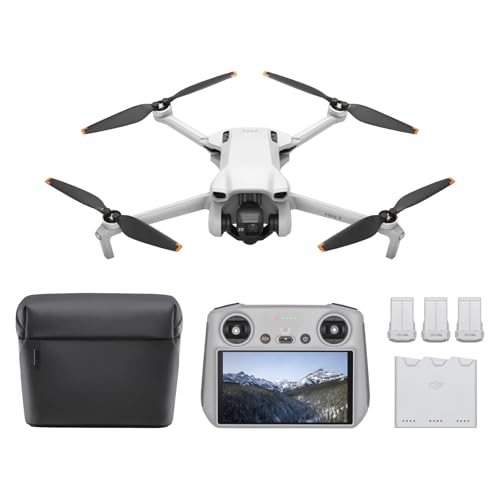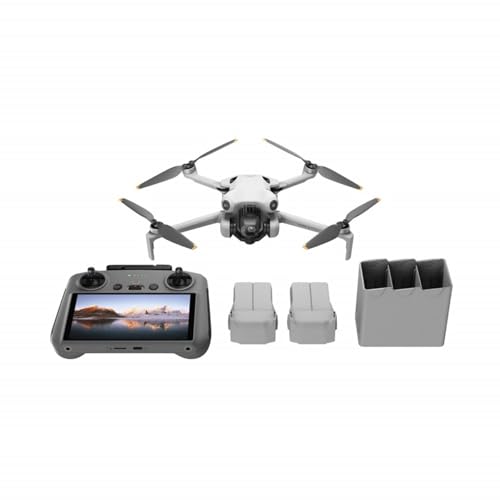Ever tried to capture that perfect aerial shot, only for a pesky gust of wind to send your drone wobbling like a jelly? It’s a common frustration for drone pilots, especially when you’re investing in quality gear like a DJI. Finding the best DJI drone for wind resistance isn’t just about avoiding blurry footage; it’s about flight safety, reliability, and ultimately, getting the shot you envision, no matter the weather conditions.
DJI is renowned for its cutting-edge drone technology, and a significant part of that innovation goes into ensuring stable flight performance, even when Mother Nature throws a curveball. From powerful brushless motors to advanced gimbal stabilization and intelligent flight algorithms, these drones are engineered to stand up to surprisingly strong breezes.
In this guide, we’ve rounded up seven top DJI drones that truly excel when the wind picks up. Whether you’re a beginner looking for a reliable first drone or an experienced aerial photographer needing robust performance, we’ve got you covered. Let’s dive in and see which DJI drone will help you conquer those gusty skies!
1. DJI Mini 4K Camera Drone Combo

The DJI Mini 4K Camera Drone Combo is an excellent all-rounder, especially if you’re looking for a drone that’s easy to fly and won’t require FAA registration for recreational use, thanks to its sub-249g weight. What truly makes it shine in varied conditions is its impressive 38kph (Level 5) wind resistance. This means you can keep flying and capturing stunning 4K UHD footage with its 3-axis gimbal, even when other lightweight drones might be grounded. The combo also provides extra batteries and accessories, ensuring you have plenty of flight time for your adventures.
Key Features:
– No FAA registration needed (under 249g)
– 4K Ultra HD & 3-Axis Gimbal for cinematic quality
– 38kph (Level 5) wind resistance for stable flight
– 10km Max HD Video Transmission range
– Extended battery life options (up to 93 minutes with 3 batteries)
– Beginner-friendly features like GPS Return to Home (RTH)
– Intelligent QuickShots for professional-level videos
Pros:
– Excellent wind resistance for its size
– High-quality 4K camera with stable gimbal
– Extremely portable and lightweight
– Long video transmission range
– Comprehensive combo with useful accessories
Cons:
– DJI Fly app requires direct download from DJI website (not on Google Play)
– Limited obstacle avoidance compared to higher-end models
User Impressions:
Users frequently praise the Mini 4K for its surprising stability in wind, often commenting on how such a small drone can hold its position so well. Many beginners appreciate its ease of use and the sharp 4K footage it delivers, making it a fantastic entry point into aerial photography without worrying too much about moderate breezes.
2. DJI Mini 4K, Drone with 4K UHD Camera for Adults

This version of the DJI Mini 4K offers the same fantastic drone capabilities as the combo but in a more basic package, making it an affordable entry point for beginners. You still get that crucial 38kph (Level 5) wind resistance, ensuring your drone for adults stays steady as a rock even when the wind tries its best to push it around. It’s perfect for those who want to experience cinematic 4K video and stable flight without the extra bells and whistles of a larger bundle right away, knowing they can always expand later.
Key Features:
– No FAA registration needed (under 249g)
– 4K Ultra HD & 3-Axis Gimbal for smooth footage
– 38kph (Level 5) wind resistance
– Extended battery life options available
– Beginner-friendly and safe flight modes
– Intelligent QuickShots for creative filming
– Includes 1 battery and RC-N1C remote controller
Pros:
– Great value for money for a 4K, wind-resistant drone
– Highly portable and lightweight design
– Reliable flight stability in windy conditions
– Easy to learn for new pilots
– High-quality camera performance
Cons:
– Only includes one battery, limiting flight time initially
– DJI Fly app download requires an extra step for Android users
User Impressions:
Customers often highlight the Mini 4K’s impressive video quality and its robust flight performance, especially in light to moderate winds. It’s a favorite among those looking for an affordable yet capable drone that doesn’t feel flimsy, even in gusty conditions.
3. DJI Mini 4K Fly More Combo, Drone with 4K UHD

For the serious aerial content creator who doesn’t want to be interrupted by battery anxiety, the DJI Mini 4K Fly More Combo is the answer. It packs all the brilliant features of the Mini 4K, including its excellent 38kph (Level 5) wind resistance, and supercharges your flight time with three batteries, a two-way charging hub, and a shoulder bag for easy transport. This means more time in the air capturing breathtaking 4K footage and less time worrying about finding a charging port, making it truly one of the best DJI drone for wind resistant adventures.
Key Features:
– No FAA registration needed (under 249g)
– 4K Ultra HD & 3-Axis Gimbal for stunning visuals
– 38kph (Level 5) wind resistance
– 10km Max HD Video Transmission
– Uninterrupted creation with up to 93 minutes of flight time (with 3 batteries)
– Beginner-friendly with GPS RTH and stable hovering
– Boost inspiration with Intelligent QuickShots
– Includes 3 batteries, two-way charging hub, and shoulder bag
Pros:
– Extended flight time perfect for longer shoots
– Superior wind stability for its class
– Highly portable and comprehensive kit
– Outstanding video transmission range
– Excellent for travelers and content creators
Cons:
– Still requires DJI Fly app download from DJI website
– Initial investment is higher than the single-battery option
User Impressions:
This combo receives rave reviews for its extended flight duration and the convenience of multiple batteries. Users consistently confirm its strong ability to handle winds, making it a reliable choice for capturing smooth, high-quality footage on longer outdoor sessions.
4. DJI Mini 3 Fly More Combo (DJI RC), Drones with

Stepping up the game, the DJI Mini 3 Fly More Combo with DJI RC combines the best of lightweight design with enhanced imaging capabilities, all while maintaining excellent wind resistance. It boasts 38kph (Level 5) wind resistance, ensuring steady flight for its 4K HDR video and innovative True Vertical Shooting. The inclusion of the DJI RC, with its built-in screen, simplifies the flying experience even further. This combo is designed for drone pilots who desire superior image quality and extended operational flexibility without needing to register their drone.
Key Features:
– No FAA registration needed (under 249g)
– 4K HDR Video with Dual Native ISO Fusion
– True Vertical Shooting for social media content
– 38kph (Level 5) wind resistance and 3-axis gimbal
– Extended battery life (up to 114 min total with Fly More combo)
– 10km Max HD Video Transmission
– Creative QuickShots and Panorama features
– Includes DJI RC with built-in 5.5-inch HD display
Pros:
– Enhanced 4K HDR video quality
– True Vertical Shooting is a game-changer for content creators
– Outstanding wind stability for a mini drone
– DJI RC offers a seamless flying experience
– Very long total flight time with the combo
Cons:
– Intelligent Flight Battery Plus, which extends flight time, makes the drone over 249g
– Some users might find the initial cost higher than the Mini 4K
User Impressions:
Pilots are consistently impressed with the Mini 3’s ability to maintain stable flight and deliver stunning HDR footage, even in windy conditions. The True Vertical Shooting feature is a huge hit for social media, and the integrated screen on the DJI RC adds a layer of convenience that many appreciate.
5. DJI Mini 3 (DJI RC), Lightweight 3x Mechanical Gimbal

The DJI Mini 3 (DJI RC) offers a compelling package for those seeking high-quality aerial imagery and stable flight without the full Fly More accessories. It shares the same impressive 38kph (Level 5) wind resistance as its combo counterpart, making it a strong contender for the best DJI drone for wind in its class. Coupled with its 4K HDR camera and True Vertical Shooting, this drone is perfect for capturing breathtaking landscapes or dynamic social media content with superior stability, especially with the convenient DJI RC included.
Key Features:
– No FAA registration needed (under 249g)
– 4K HDR Video with Dual Native ISO Fusion
– True Vertical Shooting for easy sharing
– 38kph (Level 5) wind resistance and 3-axis gimbal
– Extended battery life possible with optional Intelligent Flight Battery Plus
– 10km Max HD Video Transmission
– Creative QuickShots and Panorama
– Includes DJI RC with built-in 5.5-inch HD display
Pros:
– Excellent image and video quality with HDR
– Superb stability in moderate winds
– DJI RC streamlines the flight experience
– Highly portable and robust design
– Ideal for creative casual flying
Cons:
– Only one battery included, so additional batteries might be desired
– Intelligent Flight Battery Plus makes it exceed 249g (requires registration)
User Impressions:
Customers love the Mini 3’s combination of portability, image quality, and reliable wind handling. The DJI RC is frequently highlighted as a major plus, providing a smoother and more immersive control experience compared to using a smartphone.
6. DJI Air 3S (RC-N3), Drone with Camera 4K, Dual-Camera

The DJI Air 3S (RC-N3) represents a significant leap for aerial photography and videography, offering a more robust and feature-rich experience. While not explicitly stating a “Level 5″ wind resistance like the Mini series, its larger size, more powerful motors, and advanced stability systems inherently provide superior wind handling capabilities. This drone with camera 4K is designed for those who demand professional-grade stability and image quality, featuring a 1” CMOS primary camera and cinematic 4K/60fps HDR video, making it an excellent choice for challenging weather conditions. Its advanced features like LiDAR obstacle sensing further enhance safety and stability.
Key Features:
– Enhanced 1″ CMOS primary camera for low-light performance
– Cinematic 4K/60fps HDR video with 14 stops of dynamic range
– Dual-camera system for versatile shooting (features suggest Air 3 capability)
– Free Panorama Mode for expansive shots
– Safer nighttime flying with Forward-facing LiDAR and omnidirectional obstacle sensing
– Next-Gen Smart Return-To-Home (RTH)
– Extended flight (45-min max) & 20km video transmission
Pros:
– Exceptional camera quality for professional results
– Highly stable flight performance even in strong gusts due to size and power
– Advanced safety features like omnidirectional obstacle sensing
– Long flight time and video transmission range
– Robust build quality for reliability
Cons:
– Heavier than the Mini series, requiring FAA registration
– Battery charger sold separately
– Higher price point reflects its professional capabilities
User Impressions:
Users laud the Air 3S for its incredible image quality and rock-solid stability. Many comment on how confident they feel flying it in windy coastal or mountainous regions where smaller drones would struggle. The extended flight time and advanced obstacle sensing are also frequently praised.
7. DJI Avata 2 Fly More Combo (1 Battery), FPV Drones

The DJI Avata 2 Fly More Combo offers an exhilarating FPV (First Person View) experience, designed for immersive and dynamic flight. While FPV drones have a different approach to stability than traditional camera drones, the Avata 2 is built with integrated propeller guards and a robust design that allows it to handle dynamic maneuvers and maintain control even in various wind conditions. It’s not about hovering perfectly still, but about empowering you to perform jaw-dropping flips and rolls with confidence. This drone provides a unique adrenaline rush while capturing super-wide 4K footage.
Key Features:
– Adrenaline-Pumping Immersive Flying with goggles
– Intuitive Motion Control for easy, natural flight
– Easy ACRO mode for pro-level maneuvers
– Tight Shots in Super-Wide 4K/60fps footage
– Built-in Propeller Guard for enhanced safety and durability
– Hassle-Free POV Content creation with LightCut app
– FAA Remote ID Compliant
Pros:
– Unmatched immersive FPV flight experience
– Robust design with propeller guards enhances durability and wind handling for FPV
– User-friendly motion controller for intuitive flying
– Excellent for dynamic, cinematic FPV footage
– Ready-to-fly combo with Goggles 3 and RC Motion 3
Cons:
– FPV flying has a steeper learning curve for precise camera work
– Shorter flight time compared to photographic drones
– Requires activation via DJI Fly app (download from DJI website)
User Impressions:
FPV enthusiasts rave about the Avata 2’s ease of use for an FPV drone and its ability to withstand bumps and gusts thanks to its protected design. They highlight the incredible immersive experience and the creative freedom it provides for capturing unique, dynamic perspectives in windier environments.
Frequently Asked Questions (FAQ)
Q1: How does wind affect drone flight and stability?
A1: Wind affects drones by increasing drag, pushing them off course, and requiring more power to maintain position. Strong gusts can destabilize a drone, leading to shaky footage, loss of control, or even a crash. Drones with higher wind resistance ratings use more powerful motors, advanced flight algorithms, and sometimes heavier designs to counteract these forces, ensuring stable flight performance.
Q2: What does “Level 5 wind resistance” mean for a DJI drone?
A2: “Level 5 wind resistance” typically refers to a drone’s ability to withstand winds up to 38 kilometers per hour (or about 24 miles per hour). This is a common rating for many DJI Mini series drones, indicating they can maintain stable flight and control in moderately strong winds, which is quite impressive for their lightweight design.
Q3: Are lighter drones inherently worse in windy conditions?
A3: Not necessarily. While heavier drones often have more inertia to resist wind, DJI has engineered its lightweight Mini series drones with powerful brushless motors and sophisticated flight control systems that give them surprising stability in windy conditions. However, in extremely strong winds, a heavier, more powerful drone like the Air series will generally perform better.
Q4: Can I fly my DJI drone in very strong winds?
A4: It’s generally not recommended to fly any drone, even those with high wind resistance, in very strong or gusty winds that exceed the manufacturer’s specified limit. Doing so can risk losing control of your drone, damaging it, or causing injury. Always check local weather conditions and your drone’s specifications before taking off. When in doubt, it’s safer to stay grounded.
Q5: What features help a drone stay stable in the wind?
A5: Several features contribute to a drone’s wind stability:
– Powerful Brushless Motors: Provide the thrust needed to fight against wind.
– Advanced Flight Control Algorithms: Continuously adjust motor speeds to maintain position.
– GPS and Vision Positioning Systems: Help the drone accurately hold its position.
– 3-Axis Gimbal Stabilization: Mechanically isolates the camera from drone movement, ensuring smooth footage even if the drone itself is swaying slightly.
– Aerodynamic Design: Reduces drag and allows the drone to cut through the wind more efficiently.
– Weight: While lighter drones can be stable, a certain amount of weight helps with inertia against strong gusts.
Q6: How can I check wind conditions before flying my drone?
A6: There are several ways:
– Weather Apps: Many weather apps provide wind speed and gust forecasts. Look for apps specifically designed for aviation or drone pilots, as they often offer more precise data.
– Anemometer: A handheld device that measures wind speed directly at your location.
– Visual Cues: Observe trees, flags, or local weather patterns. If branches are swaying heavily or flags are fully extended, it’s likely too windy.
Q7: What’s the main difference between the DJI Mini 4K and Mini 3 in terms of wind resistance?
A7: Both the DJI Mini 4K and DJI Mini 3 boast the same impressive 38kph (Level 5) wind resistance, meaning they offer comparable stability in moderate winds. The key differences lie in their camera capabilities (Mini 3 offers 4K HDR and True Vertical Shooting) and some intelligent flight features. For pure wind resistance, they perform similarly well for their class.



